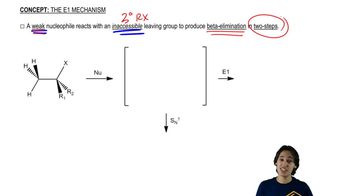Here are the essential concepts you must grasp in order to answer the question correctly.
Elimination Mechanisms
Elimination mechanisms in organic chemistry refer to the processes by which atoms or groups are removed from a molecule, resulting in the formation of a double bond. The two primary types discussed are E1 (unimolecular elimination) and E2 (bimolecular elimination), each with distinct mechanisms and conditions. Understanding these mechanisms is crucial for predicting the products of reactions and the conditions under which they occur.
Recommended video:
Intro to Substitution/Elimination Problems
E1 Mechanism
The E1 mechanism involves a two-step process where the leaving group departs first, forming a carbocation intermediate, followed by deprotonation to form a double bond. This mechanism is favored in polar protic solvents and with substrates that can stabilize the carbocation, such as tertiary alkyl halides. The rate of the reaction depends only on the concentration of the substrate, making it unimolecular.
Recommended video:
Drawing the E1 Mechanism.
E2 Mechanism
The E2 mechanism is a concerted process where the leaving group and a hydrogen atom are removed simultaneously, resulting in the formation of a double bond. This mechanism requires a strong base and is favored in polar aprotic solvents. The reaction rate depends on both the substrate and the base, making it bimolecular, and it typically occurs with primary or secondary substrates where steric hindrance is less of a concern.
Recommended video:
Drawing the E2 Mechanism.

 Verified step by step guidance
Verified step by step guidance Verified video answer for a similar problem:
Verified video answer for a similar problem:



 0:38m
0:38m